John Hancock Tower
200 Clarendon Street, previously John Hancock Tower[1] and colloquially known as The Hancock, is a 62-story, 790-foot (240 m) skyscraper in Boston. The tower was designed by Henry N. Cobb of the firm I. M. Pei & Partners and was completed in 1976.[2]
| 200 Clarendon Street | |
|---|---|
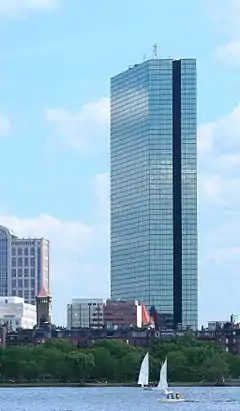 A view of Hancock Place from the Charles River | |
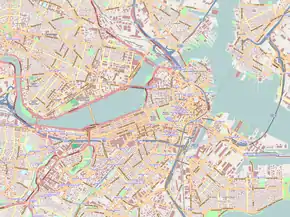 Location within Boston  John Hancock Tower (Massachusetts)  John Hancock Tower (the United States) | |
| General information | |
| Type | Office |
| Location | 200 Clarendon Street Boston, Massachusetts 02116, United States |
| Coordinates | 42°20′57.4″N 71°04′29.2″W |
| Construction started | 1968 |
| Completed | 1976 |
| Owner | Boston Properties |
| Height | |
| Roof | 790 ft (240.8 m) |
| Technical details | |
| Floor count | 62 |
| Floor area | 2,059,997 sq ft (191,380.0 m2) |
| Design and construction | |
| Architect | Henry N. Cobb of I.M. Pei & Partners |
| Developer | John Hancock Mutual Life Insurance Company |
| Website | |
| www | |
The building is widely known for its prominent structural flaws, including an analysis that the entire building could overturn under a certain wind loads — as well as a prominent design failure of its signature blue windows, which allowed any of the 500lb windows to detach and fall — up to the full height of the building — endangering pedestrians below.
In 1977, the American Institute of Architects presented the firm with a National Honor Award for the building, and in 2011 conferred on it the Twenty-five Year Award.[3] It has been the tallest building in Boston and New England since 1976.
The street address is 200 Clarendon Street, but occupants use both "Hancock Place" and "200 Clarendon Street" as mailing addresses for offices in the building. John Hancock Insurance was the primary tenant of the building at opening, but the company announced in 2004 that some offices would relocate to a new building at 601 Congress Street, in Fort Point, Boston.
The tower was originally named for the insurance company that occupied it. The insurance company, in turn, was named for John Hancock, whose large and conspicuous signature on the Declaration of Independence made his name so famous in the United States that a colloquialism for a signature is "a John Hancock".[4]
Architecture
Minimalism was the design principle behind the tower. The largest possible panes of glass were used, there are no spandrel panels, and the mullions are minimal. Cobb added a geometric modernist twist by using a parallelogram shape for the tower floor plan. From the most-common views, this design makes the corners of the tower appear very sharp. The highly-reflective window glass is tinted slightly blue, which results in the tower having only a subtle contrast with the sky on a clear day. As a final modernist touch, the short sides of the parallelogram are each marked with a deep vertical notch, breaking up the tower's mass and emphasizing its verticality. In late evening, the vertical notch to the northwest catches the last light of the sky, while the larger portions of glass reflect the darkening sky.
A major concern of the architects while designing the tower was its proximity to Boston's Trinity Church, a prominent National Historic Landmark. Their concern led them to redesign the tower's plans, as there was a public outcry when it was revealed that the Hancock Tower would cast its shadow on the church.[5]
- Visual aspects
 Full vertical view of the John Hancock Tower
Full vertical view of the John Hancock Tower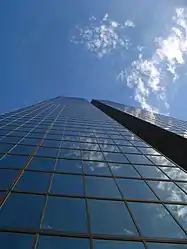 Cloud reflections on the glass sheathing
Cloud reflections on the glass sheathing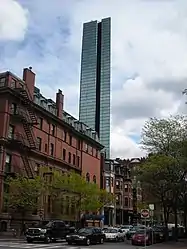 The dark vertical notch is prominent in this view
The dark vertical notch is prominent in this view
Engineering flaws
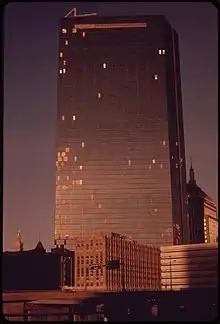
The building was a much-anticipated landmark designed by a well-respected architect, but was known in the 1970s for its engineering flaws as well as for its architectural achievement. The opening of the building was delayed from 1971 to 1976, and the total cost is rumored to have increased from $75 million to $175 million. It was an embarrassment for the firm, for modernist architects, and for the architecture industry.[6]
During the excavation for the tower's foundation, temporary steel retaining walls were erected to create a space in which to build. The walls warped, giving way to the clay and mud fill of the Back Bay which they were supposed to hold back. The shifting soils damaged utility lines, the sidewalk pavement, and nearby buildings—including the historic Trinity Church across St. James Avenue. Trinity Church won an $11 million lawsuit to pay for repairs.[7]
There were problems with the innovative use of blue reflective glass in a steel tower: entire 4′ × 11′, 500-lb (1.2 × 3.4 m, 227 kg) windowpanes detached from the building and crashed to the sidewalk hundreds of feet below. Police closed off surrounding streets whenever winds reached 45 mph (72 km/h). Under the direction of Frank H. Durgin of MIT's Wright Brothers Wind Tunnel a scale model of the entire Back Bay and an aeroelastic model of the John Hancock Tower were built and tested in the wind tunnel to identify the problem. The research raised questions about the structural integrity of the entire building (due to unanticipated twisting of the structure), but did not account for the loss of the glass panels. An independent laboratory eventually confirmed that the failure of the glass was due to oscillations and repeated thermal stresses caused by the expansion and contraction of the air between the inner and outer glass panels which formed each window; the resilient bonding between the inner glass, reflective material, and outer glass was so stiff that it was transmitting the force to the outer glass (instead of absorbing it), thus causing the glass to fail.[8]
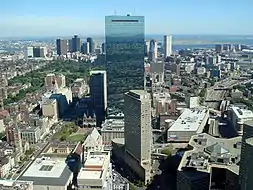
In October 1973, I.M. Pei & Partners announced that all 10,344 window panes would each be replaced by single-paned, heat-treated panels at a total cost between $5 million and $7 million.[8][7] Approximately 5,000 of the original glass panes were removed intact, and were later offered for re-use by artists.[9]
During the many months it took to diagnose and repair the building, sheets of plywood replaced many of the missing glass windows of the building, earning it the nicknames "Plywood Palace" and "Plywood Ranch" (the same name as a local lumber yard chain at the time). Bostonians joked that the Hancock Tower was "the world's tallest plywood building".
The building's upper-floor occupants suffered from motion sickness when the building swayed in the wind. To reduce the movement, contractors installed a tuned mass damper on the 58th floor.[10] As described by Robert Campbell, architecture critic for The Boston Globe:
Two 300-ton weights sit at opposite ends of the 58th floor of the Hancock. Each weight is a box of steel, filled with lead, 17 feet square by 3 feet high. Each weight rests on a steel plate. The plate is covered with lubricant so the weight is free to slide. But the weight is attached to the steel frame of the building by means of springs and shock absorbers. When the Hancock sways, the weight tends to remain still, allowing the floor to slide underneath it. Then, as the springs and shocks take hold, they begin to tug the building back. The effect is like that of a gyroscope, stabilizing the tower. The reason there are two weights, instead of one, is so they can tug in opposite directions when the building twists. The cost of the damper was $3 million. The dampers are free to move a few feet relative to the floor.
According to Campbell, engineers discovered that—despite the mass damper—the building could have fallen over under a certain kind of wind loading. The structure was assessed as more unstable on its narrow sides than on the big flat sides. Some 1,500 tons of diagonal steel bracing, costing $5 million, were added to prevent such an event.[10]
History
An observation deck with views of Boston was a tourist attraction for several decades. However, it was closed after the September 11, 2001, terrorist attacks.[11] Because of the closure of the John Hancock Tower's observation deck, the highest observation deck open to the public in Boston is in the Prudential Tower, as of 2020.
The building's owners cite security as the reason for the continued closure. They have rented the deck for private functions and have expressed intent to replace it with more office space. Boston city officials contend that security concerns are moot, since most similar attractions have long since reopened. In addition, they note that a public observation deck was a requirement for the original building permits to gain public benefit from the high tower. However, officials have not been able to locate the documentation of this requirement.[12]
In 2006, Broadway Partners acquired Hancock Place for $1.3 billion. By 2009, they had defaulted on the loans they used to buy the building, and it fell into foreclosure.[13] On March 30, 2009, Hancock Place was sold at auction for $660 million ($20 million was new equity and the $640 million of in-place debt was assumed by the buyer)[14] to a consortium of Normandy Real Estate Partners and Five Mile Capital Partners. The companies had been slowly increasing their investment over the previous months.[15] In October 2010, Boston Properties acquired the John Hancock Tower for $930 million.[16] As part of the purchase agreement, the name "Hancock Tower" would expire along with John Hancock's lease in 2015.[7]
The company that built the Hancock Tower and two earlier, similarly-named buildings is known loosely as "John Hancock Insurance", or simply "John Hancock". It was known as "The John Hancock Life Insurance Company" in the 1930s and "The John Hancock Mutual Life Insurance Company" in the 1940s. As of 2000, the company owning the buildings was "John Hancock Financial Services, Inc." with various subsidiaries such as "The John Hancock Variable Life Insurance Company" and "Signator Investors, Inc." In 2003, Manulife Financial Corporation of Toronto acquired the company, but it still uses the name "John Hancock Financial Services, Inc." and those of various subsidiaries.
The name change from "John Hancock" to "200 Clarendon" took place in mid-2015, when the eponymous company's lease expired. It had been stipulated in the leasing contract that the building would retain the name "John Hancock" only so long as John Hancock Financial was an occupant.[1]
In popular culture

About a year after the falling windows problem was resolved, American novelist John Updike wrote in a story,[10]
Now I am aware of loving only the Hancock Tower, which has had its missing pane restored and is again perfect, unoccupied, changeably blue, taking upon itself the insubstantial shapes of clouds, their porcelain gauze, their adamant dreaming. I reflect that all art, all beauty, is reflection.
The TV series Fringe shows the building as the location of FBI Headquarters. However, the actual FBI Boston headquarters were located at One Center Plaza,[17] although the FBI has since relocated to nearby Chelsea.
In September 2015, the French photographer and artist JR created a 150-by-86-foot (46 by 26 m) tall mural of a man wearing shorts, between the 44th and 50th floors of the building. According to the property manager, the mural was the final piece in a three-part series of temporary public art projects at the building.[18][19]
In the 2019 film Godzilla: King of Monsters, the John Hancock Tower is depicted being destroyed in the battle between Godzilla and King Ghidorah when the former behemoth pushes the alien into the building.
See also
- John Hancock, for whom John Hancock Insurance was named
- Prudential Tower for an image of the Boston skyline from Cambridge in 1963, with the old 26-story Hancock building a conspicuous landmark.
- List of tallest buildings by U.S. state
- List of tallest buildings in Boston
References
Notes
- Logan, Tim. "So, what should we call the John Hancock Tower now?". The Boston Globe. Retrieved 2016-01-19.
- "John Hancock Tower". Pei Cobb Freed & Partners. Retrieved 2013-07-22.
- "Twenty Five Year Award Recipients". American Institute of Architects. Retrieved 2013-07-03.
- "American Heritage Dictionary". Retrieved 2017-04-24. "John Hancock n. Informal: A person's signature. [After John Hancock (from the prominence of his signature on the Declaration of Independence).]
- Farragher, Thomas (24 September 2006). "Hancock Tower at 30: 60 stories and countless tales". The Boston Globe. boston.com. Retrieved 2013-07-22.
- Wiseman, Carter (1 September 1990). I.M. Pei: A Profile in American Architecture. New York: Harry N. Abrams. pp. 139–153. ISBN 978-0810937093.
- Goodison, Donna (July 31, 2015). "Hancock signs off as name of tower". The Boston Herald. Retrieved January 19, 2016.
- Levy, Matthys; Salvadori, Mario (1992). Why Buildings Fall Down. W.W. Norton and Company. pp. 203–205. ISBN 9780393311525. Retrieved 2013-07-22.
- "How Art Springs Forth From Broken Windows". The New York Times. NYTimes.com. 3 January 1988. Retrieved 2013-07-22.
- Campbell, Robert (3 March 1995). "Builder Faced Bigger Crisis Than Falling Windows". The Boston Globe. The Pulitzer Prizes. Archived from the original on July 29, 2013. Retrieved 2013-07-22.
- Colletti, Carolyn (14 September 2001). "Hancock Tower observatory is shut permanently". The Boston Globe. boston.com. Retrieved 2013-07-22.
- Park, Madison (15 June 2005). "Searching for an answer on 60th floor". The Boston Globe. boston.com. Retrieved 2013-07-22.
- Gross, Daniel; Stuart Johnson (5 September 2009). "The Skyscraper That Ate a Billion Dollars: Boston's Hancock Tower and the coming commercial real estate crisis". Slate.
- Yu, Hui-Yong; Green, Peter S. (31 March 2009). "Hancock Tower Sells at About Half Price to Normandy". Bloomberg BusinessWeek. Retrieved 2013-07-22.
- Ross, Casey (31 March 2009). "Hancock Tower sells for $660m at auction". The Boston Globe. boston.com. Retrieved 2013-07-22.
- "Boston Properties buys Boston tower for $930M". Bloomberg BusinessWeek. Associated Press. Archived from the original on 2010-10-07. Retrieved 2013-07-22.
- Gallagher, Tina (14 September 2011). "'Fringe' Trivia: 10 Things You Didn't Know About Your Favorite Show". Yahoo!. Retrieved 2013-07-22.
- Annear, Steve (2015-09-24). "Mystery solved: mural on ex-Hancock Tower the work of French artist". The Boston Globe. Retrieved 2015-09-25.
- Smee, Sebastian (September 25, 2015). "With Hancock piece, the public gets an imposing and intriguing gift". The Boston Globe. Retrieved 2015-09-25.
Sources
- Location and size of mass dampers: telephone conversation with Richard Henige, LeMessurier Consultants, Inc.
- Oct. 15, 1973. "Those Window Pains", TIME.
- Harl P. Aldrich, James R. Lambrechts (Fall 1986). "Back Bay Boston, Part II: Groundwater Levels", Civil Engineering Practice, Volume 1, Number 2.
External links
| Wikimedia Commons has media related to John Hancock Tower. |
- John Hancock Tower at Structurae
- library-towers John Hancock Tower
- Architecture Week When Bad Things Happen to Good Buildings
- The Perfect Skyscraper The Perfect Skyscraper
- Special Report on the Boston Globe; "The Hancock at 30" includes 4 audio slideshows
- Globe Critic, Robert Campbell, on the problems of the John Hancock Tower
- So, what should we call the John Hancock Tower now? (photos of construction)
| Preceded by Prudential Tower |
Tallest Building in Boston 1976–present 241 m |
Succeeded by None |
